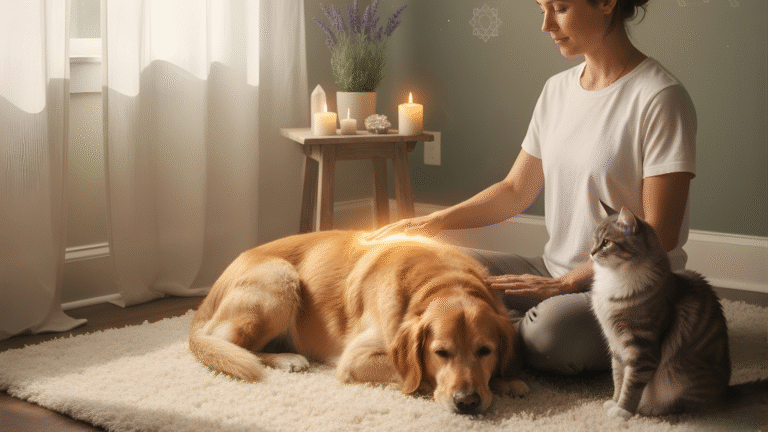What To Expect During Your Pet’s First Reiki Treatment
If you’re new to energy healing, it’s natural to wonder what to expect during your pet’s first Reiki treatment, how your animal will react, and whether the experience will feel comforting for them. Booking your pet’s first Reiki session can feel both exciting and a little mysterious.
I remember bringing my own rescue dog for a session years ago — hopeful, but unsure. I wanted something that could ease her anxiety without adding stress.
Watching her settle, breathe more deeply, and soften into the moment showed me just how powerful gentle energy work can be for animals.
Reiki is a calming, noninvasive practice that supports emotional balance and helps pets feel safe and grounded. Many pet parents notice that it eases stress, encourages relaxation, and brings comfort to animals with sensitivities or past trauma.
Before you head into your pet’s first appointment, here’s a clear, warm guide to help you feel confident about what to expect during your pet’s first Reiki treatment and how to prepare your animal for a peaceful experience.
Reiki is a form of energy healing that originated in Japan. The word “Reiki” loosely translates to “universal life energy,” and the practice focuses on supporting the natural flow of energy throughout the body.
Instead of physical manipulation, Reiki uses light touch—or no touch at all—to encourage balance, relaxation, and emotional ease.
Animals are naturally sensitive to energy and often respond even more quickly than humans. Many people describe their pets becoming more grounded, calm, or trusting after a session. Some even drift into a soft sleep, while others quietly observe and stay close to the practitioner.
Growing interest in holistic wellness has made Reiki more common in shelters, veterinary clinics, animal sanctuaries, and pet households.
While scientific research in animals is still emerging, early studies and countless real-life stories show promising results, especially for stress reduction and emotional support.
How to Prepare For Your Pet’s First Reiki Session
Preparation doesn’t require much, but a few thoughtful steps can help your pet feel relaxed and safe:
1. Create A Quiet Atmosphere
Choose a time of day when your pet is naturally calmer. Avoid scheduling a session right after meals, excitement, or extended outings.
2. Bring Familiar Comforts
A favourite blanket, bed, or toy can help your pet feel centred in a new space.
3. Share Helpful Background Info
Let the practitioner know about your pet’s health history, sensitivities, or behaviours. The more they understand, the better they can tailor the session.
4. Allow Natural Freedom
If possible, avoid keeping your pet on a tight leash. Let them wander, sniff, approach, or step away—the freedom helps them feel in control.
Being relaxed yourself also helps. Animals pick up on our emotional state more than we realize. A slow breath or two before you begin can make the whole experience smoother.
What Happens During A Reiki Session?
When you arrive, the atmosphere is usually peaceful—soft lighting, a cozy blanket or mat, and a quiet room. The practitioner will greet your pet gently and give them time to explore.
Consent is a central part of animal Reiki. The practitioner observes your pet’s body language and only proceeds when the animal shows interest or comfort. If your pet chooses to sit beside the practitioner, great. If they want to lie down across the room, that’s also perfect.
The practitioner uses either light touch or hands positioned just above the body. Many start near the head or shoulders and move gently along the body, but they always follow the pet’s cues.
Sessions usually last 20–60 minutes, depending on your pet’s comfort level. Some animals relax deeply and stay still, while others shift positions, get up briefly, or check in from different angles. All of this is normal and welcomed.
What Your Pet Might Feel Or Experience
Every animal reacts in their own way, but here are some typical responses:
- Softening of the body—lowered shoulders, relaxed hips, slow blinking
- Deep breathing or gentle sighs
- Twitching, yawning, stretching, or tummy gurgles as tension releases
- Dozing off or becoming very calm and still
- Seeking closeness or gently touching the practitioner
- Needing breaks, wandering away and returning when ready
- Quiet alertness, as if they’re observing the energy work
Some pets take a few minutes to settle into the experience, especially if they’re young, anxious, or in a new environment. Others relax almost immediately.
If your pet becomes restless or uncomfortable, practitioners typically pause, shift positions, or adjust the approach. The priority is always the animal’s comfort, not completing a specific routine.
Benefits Of Reiki For Pets
Many pet owners seek Reiki for specific reasons, but even without a clear “problem,” animals often respond beautifully to the calming energy. Here are some of the most common benefits you may notice:
1. Stress And Anxiety Relief
Pets who struggle with loud noises, new environments, separation, or past trauma often soften during a session. Reiki helps guide them gently into a state of relaxation, which can be especially soothing for nervous or sensitive animals.
2. Support During Recovery
Animals healing from surgery, illness, or injury may benefit from the calming support Reiki offers. While it’s not a medical treatment, the relaxed state can help reduce tension, promote rest, and create an environment that encourages natural healing.
3. Emotional Balance And Behaviour Improvements
Some pets carry emotional stress that shows up as restlessness, reactivity, aggression, or clinginess. Reiki can help them feel more grounded and stable, making it easier for behavioural strategies to work.
4. Transition Support
When your household is changing—moving to a new home, adding a new pet, or welcoming a baby—Reiki can help your animal adjust with more confidence and ease.
5. Comfort For Senior Or Terminally Ill Pets
For aging companions or those in palliative care, Reiki can offer emotional comfort and moments of deep rest. Many pet parents describe these sessions as precious bonding experiences.
These benefits don’t show up the same way for every pet, but even subtle changes—relaxed breathing, softer expression, a willingness to settle—can signal that the energy work is helping.
Want to Share Your Love for Pet Reiki?
Discover how rewarding it can be to bring healing energy and compassion to pets — and to share that passion online with others.
What To Keep In Mind Before And After A Session
Reiki works best when approached with gentle expectations. It’s not a dramatic, instant cure, and it doesn’t replace veterinary care, but it can offer meaningful support.
1. Be Patient
Some pets take a few sessions to relax fully or show noticeable changes. Every animal has their own pace.
2. Observe And Track
Pay attention to changes in your pet’s behaviour, sleep, appetite, or mood over the next few days. A simple journal or reminder on your phone can help you notice gradual shifts.
3. Keep Communication Open
If you’re unsure about how often to schedule sessions or what’s normal, ask your practitioner. They can help you understand your pet’s responses and guide you through the process.
4. Work With Your Veterinarian
Reiki is meant to complement medical care, not replace it. For pets dealing with chronic issues or recent procedures, keeping your vet in the loop is always helpful.
5. Allow Freedom After The Session
Some animals want extra affection afterwards. Others prefer to nap in a quiet corner. Let them choose how to integrate the experience.
Possible Challenges Or Concerns During Pet Reiki
Not all pets settle instantly, and that’s perfectly normal. Here are a few things you may encounter:
1. Restlessness Or Wandering
Young, curious, or high-energy pets might move around the room at the beginning. Reiki doesn’t require stillness—many animals relax after a few minutes of exploring.
2. Mild Uncertainty Or Resistance
Some pets need time to understand what’s happening. A respectful practitioner will adjust the approach and honour your pet’s boundaries.
3. Quiet Or Subtle Responses
Not every animal shows dramatic reactions. Some shift gradually—you may notice calmness later in the day or the next morning instead of during the session.
4. Skepticism From Owners
It’s natural to wonder whether Reiki is working, especially if you’re new to energy healing. When owners continue observing their pets calmly over several sessions, they often begin noticing small but meaningful shifts.
5. Underlying Medical Conditions
Make sure your practitioner understands your pet’s physical needs, mobility limitations, or sensitivities. Ethical practitioners never diagnose or interfere with veterinary treatments.
The best Reiki sessions happen when everyone—pet, practitioner, and pet parent—works as a team to create a calm, supportive environment.
Advanced Tips: Helping Your Pet Get The Most From Reiki
Once you’ve had a session or two and feel more comfortable with the process, you may want to explore a few ways to deepen your pet’s experience:
1. Choose A Practitioner With Animal Experience
Reiki for pets isn’t the same as Reiki for humans. Practitioners who specialize in animals understand body language, consent cues, and species-specific needs. Don’t hesitate to ask about their background or training.
2. Consider In-Home Sessions
Many animals relax more easily in familiar surroundings. If your pet is anxious, reactive, or sensitive to new environments, home-based or distance sessions may feel gentler and more supportive.
3. Use What Comforts Your Pet
Certain routines help your pet settle. A favourite treat afterwards, a soft blanket, a calming playlist, or a slow walk can create positive associations with the session.
4. Stay Open To Different Outcomes
Reiki sessions don’t always look the same. Sometimes they lead to deep sleep, and other times your pet might feel energized, playful, or cuddly. Pay attention to their behaviour over the next 24–48 hours to get a full picture.
Real-World Examples Of Animal Reiki
Reiki is being used in a variety of settings, each with its own gentle, meaningful stories:
1. Shelter And Rescue Pets
Animal shelters often use Reiki to support new arrivals or animals who show fear, withdrawal, or stress. Many report that shy pets begin to make eye contact, accept touch, or explore their surroundings more confidently after a few sessions.
2. Senior And Chronically Ill Animals
Older pets or those in hospice care often respond warmly to Reiki. Sessions can help them rest more comfortably, ease tension, and enhance their connection with their human companions.
3. Pets In Transition
Families who move, renovate, travel, or welcome new family members frequently use Reiki to help their animals adapt. These sessions can soften behavioural changes, reduce nervousness, and create a sense of grounding during stressful moments.
These examples show how adaptable and intuitive Reiki can be, meeting each animal exactly where they are.
Frequently Asked Questions
Q1: Is Reiki Safe For All Pets?
Yes. Reiki is gentle, soothing, and appropriate for nearly all species—dogs, cats, rabbits, birds, reptiles, and even larger animals like horses. Practitioners simply modify their approach based on your pet’s needs and comfort level.
Q2: Does My Pet Need To Stay Still During The Session?
Not at all. Many animals move around, shift positions, or briefly leave the space. Reiki is most effective when it follows the animal’s natural rhythm rather than forcing them to remain in one spot.
Q3: How Many Sessions Does My Pet Need?
This depends on your pet’s emotional and physical needs. Some animals benefit from periodic sessions, while others do well with shorter sessions more often—especially during stressful periods. Your practitioner can help you decide what works best.
Q4: Can Reiki Replace Veterinary Care?
Reiki is a complementary wellness practice. It supports relaxation, emotional balance, and overall well-being, but it is not a substitute for veterinary diagnosis or treatment. Always partner with your vet, especially if your pet is unwell.
Q5: How Will I Know If My Pet Enjoyed The Session?
Many pets show subtle signs afterward, like deeper sleep, softer body language, more affection, or a calmer mood. Some animals even seek out the practitioner again the next time they visit. Every pet is different, so noticing gentle shifts over the next day or two can be a good indicator.
Q6: Do I Need To Stay With My Pet During The Session?
Most practitioners welcome your presence because it helps your pet feel safe. Some animals relax more deeply when they can see or smell their person. If your pet is independent, you can step out briefly — but staying nearby is usually comforting for them.
Q7: Can Pets Become Overstimulated During Reiki?
It’s uncommon, but some very sensitive animals may need shorter or lighter sessions. If your pet seems restless, yawns excessively, shakes off, or wants to move away, your practitioner will respect their boundaries and adjust the energy work accordingly.
Q8: Does Distance Reiki Work For Pets?
Yes. Many practitioners offer distance sessions for anxious, reactive, or mobility-challenged animals. Pets don’t need to be touched to receive the benefits — intention, focus, and the practitioner’s presence are the key elements.
Q9: How Should I Support My Pet After The Session?
Let your pet rest, drink water, and unwind at their own pace. Some animals prefer a quiet nap, while others may want a short walk or gentle play. Giving them space to process the experience is the most helpful thing you can do.
Q10: Can Reiki Help With Behavioural Issues?
Reiki isn’t a cure for behavioural challenges, but it can support emotional balance. Many pet parents notice improvements when Reiki is paired with positive reinforcement training, routine, and guidance from a certified behaviourist.
Wrapping Up: Reiki And Your Pet’s Well-Being
Trying Reiki with your pet is a wonderful way to offer comfort, emotional support, and a sense of balance. Each session creates a calm, nurturing space where your animal can relax at their own pace.
Whether your pet is dealing with anxiety, recovering from a challenge, or simply enjoying a peaceful moment in their day, Reiki provides a gentle path toward well-being. What matters most is giving your pet choice, space, and compassion—three things animals respond to beautifully.
Many pet parents find that Reiki doesn’t just soothe their animals; it also strengthens the bond they share. When your pet settles, sighs, or nudges closer during a session, it’s a reminder of how deeply our animals connect with us and how much they appreciate our efforts to support their emotional world.
Reiki offers an invitation to slow down, tune in, and walk side by side with your pet toward comfort and calm. And sometimes, that quiet moment of peace together is precisely what both of you need.
I trust you enjoyed this article on What to Expect During Your Pet’s First Reiki Treatment. Please stay tuned for more Reiki insights, pet wellness tips, and holistic lifestyle ideas.
Take care!
— JeannetteZ
💬 Your Opinion Is Important To Me
Do you have thoughts, ideas, or questions? I’d love to hear from you. Please leave your comments below or email me directly at Jeannette@pawreiki.com.
📚 More PawReiki Reads — Discover Energy Healing & Holistic Pet Wellness
💜 My #1 Recommendation for Online Success
Reiki has brought so much peace and purpose to my life, and sharing it online has been a true blessing. If you’ve ever dreamed of creating a gentle income stream around your love for animals and holistic healing, this platform gives you all the tools, training, and community support you need — no tech experience required.
🌟 See How Reiki Lovers Build Online Income — Try WA Free
No credit card required · Free starter training included
Disclosure
This post may contain affiliate links. As an Amazon Associate and participant in other affiliate programs, I earn from qualifying purchases at no extra cost to you. Please read my full affiliate disclosure.







